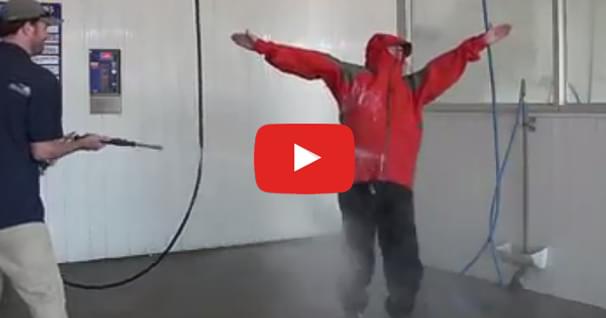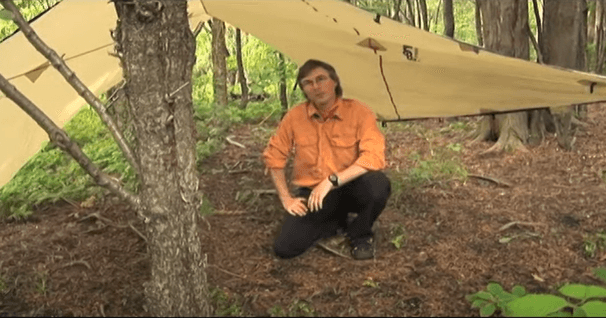Rain Gear for Paddlers
Slowly, it begins, first with a gentle rain that lasts an hour. Then the storm intensifies, ultimately erupting into a persistent downpour. You're warm and dry in your two-piece rain suit. Not so in the bow, where paddling cadence has slowed and conversation is reduced to occasional groans.
At first, you're amused that your partner's rain coat leaks, while yours works fine. But as the weather worsens, your friend begins to shiver. You'd better put ashore immediately and get him into dry clothes. If this scenario sounds familiar, you're not alone. Few boaters can boast rain wear that works in an all day rain. Surprisingly, cost and performance don't always go hand in hand. It's more a matter of good design and construction than special fabrics or showroom style.
Conventional rain coats are for city slickers, not for active outdoors people. Boaters should choose a two piece rain-suit or a cagoule.
Cagoules (sometimes called knee-length fishing shirts) are full-cut, calf-length, over-the-head parkas. They have large hoods and a waist-length zipper that closes to the nose. Cagoule's are lighter, better ventilated and less expensive than two piece rain-suits. It's a hassle to put on and take off a two piece rain suit in a canoe or kayak-- especially, as short showers come and go. But Cagoules go on fast. The open skirt allows air to circulate and moisture to dissipate. When the rain momentarily stops, hike up the hem and allow your legs to breath. Drop the skirt when the shower returns. An easy over- the-head pull removes the garment.
Cagoule's, like ponchos, may be dangerous in a capsize, so whitewater paddlers should avoid them. But they're ideal for placid flatwater routes. You'll find Cagoules at camping and fishing shops and in some big chain discount stores. If you get a blank stare when you ask for "a cagoule", say it's a calf-length fishing shirt.
~Get the BWCAW Tee~
With over 1,090,000 acres of wilderness area, the BWCAW is a paddler's paradise.
Rain-suits: Safety dictates that you wear a two piece rain-suit if you canoe in moving water. You'll save money if you remember that most outdoor wear is sold to arm-chair adventurers who rarely deviate from wood chip trails in state parks. Catering to those who spend real time in the wilds is economic suicide. Better to make questionably waterproof garments that look good at the All Stars game then unfashionable models that keep out rain.
Sizing: Bigger is better! I prefer a coat that's large enough to fit comfortably OVER my life jacket. Technically one should never wear anything over a PFD, but short, sporadic rains demand concessions, especially in lake country where there is little danger of capsizing. It's a hassle to put on and take off your PFD every time you add or shed rain clothes. A larger size promotes better ventilation too, though you may have to live with sleeves that are too long and a neck closure that doesn't seal. To seal a gaping neck, sew a Velcro security tab across the throat. This is standard practice on foul weather yachting attire.
BUNDLE UP AND TRY THESE TESTS
- Windmill your arms back and forth in a strong "canoe paddling" motion. Does the jacket bind anywhere -- especially at the forearms, arm pits or below your chin? If so, keep shopping; this jacket is too small!
- You should be able to fully zip the jacket-- and move actively-- while wearing your cold weather clothes and your life jacket.
- Water will dribble through elastic, snaps or button cuffs. You want Velcro or neoprene closures if you’re serious about staying dry Do the wrist tabs seal over both your bulkiest and thinnest garments? If not, can the tabs be lengthened, shortened or moved?

IMPORTANT FEATURES
• Weather flap: The best parkas have a double weather flap over the zipper. Lesser built garments have a single weather flap that is controlled with spaced snaps. Blowing rain can dribble between the snaps, through the zipper. One wide weather flap is adequate only if there's a full length Velcro strip to hold it shut.
• Pockets: Two covered pockets at the hem are all you'll ever need. Why pay for pockets you won't use?
• Lining: A lining absorbs and wicks perspiration away from your skin. It also increases the durability and warmth of the garment and makes it easier to slip over clothes. But, lined parkas are heavier, bulkier and more expensive than unlined ones. One solution is to wear a porous nylon windbreaker inside an unlined rain coat. Wear the nylon shell alone on windy days and save your rain coat for rain. It will develop fewer holes and tears-- and last much longer-- if you wear it only when necessary.
• Hem cord: A hem cord allows you to snug the garment around your waist, thereby sealing off the entry of water in a capsize. Add secure wrist closures and a tight-fitting throat strap, and the garment will protect against hypothermia in the event you capsize. Some rain jackets have a waist cord and a hem cord. You really don't need both.
• Inner cuffs: Lycra or neoprene inner cuffs prevent rain from running up your sleeves. But, double cuffs are hot and bulky and they increase the price of a rain jacket. Serious sailors will demand double cuffs; casual and hot weather boaters may be better off without them.
• Hoods: A hood should be an integral part of the jacket, not a tacked on afterthought. Detachable hoods, and those that roll and zip into collars often present big gaps (especially at the throat) to the weather. The jacket zipper should close nearly to the nose so blowing rain can’t slither down your neck. The best hoods have two drawstrings-- one of which allows the hood to turn with your head-- an important safety feature. Even the best hood designs obscure some visibility-- the reason why active people don't like them. You'll stay dry in any weather if you follow the lead of lobster fishermen and wear a big-brimmed souwester rain hat under a hoodless rain coat.
• Under-arm zippers: Many high-tech, waterproof/breathable rain jackets have zippers under the arms which can be opened for ventilation. Hikers like "pit zips" because staying cool is often more important than staying dry. But hikers generally keep their arms at their sides, which covers the zippers.. Canoeists raise them high with every paddle stroke! I have never seen a non-waterproof underarm zipper that didn't leak in prolonged rain!
• Rain pants: Some rain pants have a bib and suspenders; others have a simple waist cord. Bibs are more comfortable and waterproof, but pants with waist-cords are more practical. Buy bibbed pants only if you're willing to strip off-- and put on again-- your rain coat and PFD every time a passing shower requires you to put on rain pants.
Bigger is better! Get rain pants at least one full size larger than you think you need. The waist should open wide enough to accommodate bulky trousers. Baggy construction will allow air to circulate and perspiration to dissipate.
• Ankle closures: Ankle closures restrict ventilation—primitive man learned long ago that water doesn't flow uphill! Pant legs should by clown-like wide and hang stove-pipe straight. Trim rain pants flush with your ankle bone. A three-quarter inch wide strip of nylon twill sewn to the inside hem of each pant leg adds durability. Those with short legs should note that zippered rain pants can’t be shortened without relocating the zipper-- which is a major deal. A few hikes through mud and logging slash will do more to teach you about the stupidity of ankle zippers than anything I say here.
• Colors: Navy blue and black attract bugs. Lighter colors are neutral. Someone please tell me why navy blue is the most popular color for outdoor gear?
• Fabrics: Fabric price doesn't seriously affect the cost of a rain garment. The biggest expense is tailoring-- pockets, zippers, overlaps, double drawstrings, etc. The material used in premium discount store and construction grade rain wear is adequate for severe applications, though the tailoring may not be. You can repair most inadequacies if you have a sewing machine.
Waterproof/breathable fabrics: Gore-Tex™ was the first of the "waterproof/ breathable laminates", now there are lots of competitors. Waterproof/breathable garments are at their best on sultry summer days and in transitional weather where it alternately rains and snows. Otherwise, conventional foul weather clothes are adequate and cost much less.
WHERE TO BUY? The best buys are usually in hunting and fishing stores not in yuppie catalogs and high- end camping shops. The downside is that green, camo and "Real Tree" may be the only available colors.
UNDER GARMENTS What you wear under your rain gear is important! Begin with a wicking layer of polypropylene, polyester or wool long underwear next to your skin, then put on a wool or polyester fleece shirt. These will absorb chilling perspiration. Again, let me stress that no waterproof garment-- regardless of price-- will last long if you wear it every day. Save your rain coat for rain and wear a porous wind breaker for wind.
Cliff Jacobson is one of North America’s most respected outdoors writers and wilderness paddlers. He is a retired environmental science teacher, an outdoors skills instructor, a canoeing and camping consultant, and the author of more than a dozen top-selling books. His latest is available as a free download at the following link: www.cliffcanoe.com
Related Articles
I advise people to put a waterproof plastic groundsheet INSIDE their tent, not under the floor as…
Hi, I'm Kevin Callan and today on Body Gear we're gonna talk about rain gear. Rubber, it's not that bad…
The quality of your tarp and the skill of erecting one is more crucial on a trip than a tent. Why? It's…



